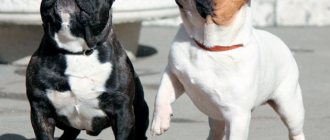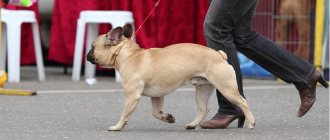French bulldogs are naturally friendly, playful, inquisitive dogs, but they also have stubbornness, self-will, obstinacy and a tendency to aggression. A dog needs a strong master's hand. You need to raise your pet from an early age so as not to miss important stages in the formation of the dog’s character. Retraining an adult bulldog will be more difficult.
Basic goals
Distantly related to French bulldogs are English bulldogs - capricious and stubborn dogs, so the owner needs to put a lot of effort into raising an easy-going dog. Raising bulldogs at home has several important goals:
- Explain to the dog the family hierarchy, make it clear who is in charge, who needs to be obeyed, who sets the rules. It is necessary to gently but persistently exclude the possibility of the dog's leadership in the family and the desire to show aggression.
- Assign the dog its own place in the house, accustom it to it, designating it with the command “place”. A bed for dogs of this breed should be located in a secluded place, away from bright light and drafts.
- Determine the daily routine and feeding. Between the appointed time, “snacks” are not allowed. Dogs are prone to obesity; the owner must monitor the pet’s health.
You need to start training your puppy at three months of age. In this way, the bulldog owner will ensure safety for himself and family members, firmly establishing his own rules, teaching the dog order and obedience.
Basics of education and training
Successful raising and training of a puppy is impossible if the natural instincts that help the dog survive in an often unfriendly natural environment are not first satisfied. In other words, the puppy should be fed, calm, warm, and healthy.
Training requires a relaxed atmosphere and a sense of security, which is achieved by the presence of a beloved owner nearby.
Raising a French Bulldog should be based on a reasonable combination of two principles: encouragement (or positive reinforcement) and reprimand (or negative reinforcement). It is very important to be able to use them correctly. The predominance of one method over another will not bring benefit, but only harm.
The correct use of incentives is as follows:
- The “reward” for a well-done task and exemplary behavior of the dog should be regular.
- The types of incentives must change. This will make your workouts varied and interesting.
- Verbal approval or affection has no less value for a dog than a treat.
The use of negative reinforcement should be based on the following rules:
- The most acceptable methods of punishment are a verbal reprimand in a stern tone, a gentle tug on the collar.
- It is very important to apply punishment within the first few minutes after the offense has been committed. Otherwise, the associative connection will be lost, and the dog will not understand why it is being punished.
- The use of physical force on an animal is unacceptable, since this can cause the development of aggression or, on the contrary, make it timid and downtrodden.
- Too lenient a punishment will not bring the expected result.
When practicing this or that command, you should not “conflict” with the French bulldog. The trainer is required to have self-control, perseverance and patience. The task will have to be repeated several times before the dog can be taught to carry it out without hesitation.
Main goals of education
Like all pack animals, dogs have a natural need to obey certain laws of society. The owner is faced with the task of conveying the established rules to the animal. If this works out, then in the end the trainer will get an easy-going, efficient dog. The main goals of raising a French bulldog at home are:
- Help the puppy determine its correct place in the family hierarchy. It is necessary to gently but confidently exclude possible claims to leadership in the family and the desire to use aggression towards its members.
- Determine a permanent place for the puppy and show it. The bed should be located in a secluded nook, away from sources of bright light and drafts. The Frenchman must know that this is a vacation spot and go there on the command “place.”
- Set specific feeding times. Avoid snacking between feedings. But fresh water should be available to the dog at all times.
From the age of three months you can start training a French bulldog. This is the most important aspect of upbringing and creating conditions for the safety of the baby and household members.
Basic aspects of training
Training a French bulldog puppy is aimed at developing a set of conditioned reflexes that are useful for the animal’s existence in human society. Ideally, the dog should learn to obey all commands without question. Good training is based on a number of basic principles that promote the rapid development of the necessary skills and habits:
- Regularity. Dogs of this breed are resourceful and try by all means to avoid following a command. The owner should establish a routine for daily activities. They should not be canceled due to one circumstance or another. Having felt the opportunity to beg for an indulgence, the dog will continue to try to use it in the future.
- Multiple repetition. Consolidating acquired skills is very important. You need to pay attention to repeating the material covered.
- No long breaks. They will lead to the fact that already developed associative connections will be destroyed, and everything will have to start all over again.
Stages of puppy development and upbringing
There are four stages in the puppy training system:
- Development.
- Adaptation.
- Socialization.
- The struggle for leadership.
Each of these stages is characterized by its own behavior of the dog, which the owner must take into account.
First
This period begins when the dog is born and lasts about seven weeks.
For the first two weeks , a newborn depends on its mother, most of all it needs food, sleep, warmth and safety.
After two weeks, the puppy perceives the world by ear and begins to distinguish it.
His mother is now the only teacher and authority for him.
At the age of three weeks, the puppy begins to explore the world on his own , at this time he is very receptive to everything that happens around him. He remembers and reinforces new actions. If the puppy develops correctly, then by the end of this period he is active, inquisitive, and ready for new explorations and learning.
Second
At the age of one to two months, the puppy receives its first life skills and adapts to life in society. The dog’s brain is actively developing and it learns to communicate with humans. Like humans, quadrupeds have different types of characters: choleric, phlegmatic, sanguine or melancholic. At this age, the puppy just begins to show his temper and here he already needs training. During this period, it is important to teach your pet to respond to its name. Commands to teach your dog:
- "To me".
- "In place."
As soon as the dog responds to its name, you need to reward it with a treat. This will reinforce a positive reaction to the name and teach the puppy the primary reflex: call - treat.
Small puppies leave puddles about 15 times a day, it is almost impossible to keep track of this, but at the age of 2 months you need to start toilet training your dog.
How to train a bulldog to a litter tray or diaper step by step:
- Equip a special place (pallet, tray. Filling - newspaper or disposable absorbent diapers).
- Reduce the area where the puppy makes puddles. For example, when laying out newspapers, reduce the “coverage area”. So the puppy is moved towards the equipped tray. The place should be secluded and quiet so that nothing distracts or frightens the puppy.
- Learn to see when the puppy wants to go to the toilet. He will spin around, whine and look for somewhere to retire. At this point it must be planted in a tray.
At the adaptation stage, it is also important to instill in the dog the skill of communicating with a person. Up to 2 months, bulldogs react friendly to all strangers; later they develop a fear of new people. Therefore, it is necessary to immediately introduce your pet to all family members and let him communicate with everyone as often as possible.
Third
The third stage occurs at the age of 2 - 4 months and is called socialization. They begin to accustom the puppy to the owner's hands so that he can be lifted and examined. Commands that need to be taught to the dog during this period:
- "Go for a walk."
- "It is forbidden".
- "Lie".
- “Come to me” and “In place” if they were not learned at an earlier age.
Under no circumstances should you spoil a dog at this age. If you do not teach your puppy obedience before 4 months, then further training will become increasingly difficult.
Even if the puppy is stubborn and doesn’t listen well, physical punishment should never be used. The dog must know that the owner's hand is for affection. The so-called “loneliness method” is used as punishment. The puppy is left alone for a while, continuing to quietly monitor him. He gets scared and gets bored. Fear displaces aggression. This method works well because French bulldogs are very sociable animals and need human company.
During this same period, puppies begin to learn to communicate with other dogs; it is important to protect them from stressful situations. In no case should any manifestation of even slight aggression towards the owner be ignored. It needs to be nipped in the bud.
Fourth
At the age of three to three and a half months, puppies begin to fight for leadership with their peers. And if the bulldog ends up in a new family, then this struggle is transferred to the owner and family members. The main task of the new owner during this period is to designate his own dominant place in the house. The rules of submission to a dog are explained under the following circumstances:
- Control during the walk. You can’t “cool down” your dog while walking. She should not pull on the leash, subordinating the owner to her actions. The puppy is limited in its movements by using the commands “fu” and “no”, while lightly patting the dog on the rear.
- Close contact. The owner must establish an emotional connection with the dog so that the bulldog understands exactly when a person is dissatisfied, when he is angry, when he is caressing the dog. If the upbringing was correct, then by three months the puppy will finally recognize the owner as the leader.
- Regular training. The commands “sit”, “stand”, “lie” are studied. Ball and frisbee games are practiced. Both the psychological and physical stress on the dog are increased.
- Buying a collar with a leash. It is during this period that the dog is accustomed to a leash and collar. This is combined with encouragement and treats so that the equipment evokes positive emotions in the dog.
Toilet training outside occurs during the same period. When the puppy begins to spin, whine, and look for a place to express his needs, he is taken outside.
Raising a Frenchman in stages
Raising a French Bulldog puppy is similar to raising a child. If you are too affectionate with a Frenchman, he will stop obeying his owner. Even if the animal is very sorry, you should not be afraid to punish it for its offenses.
Another mistake in education is the owner’s excessive severity towards the animal. The owner often forgets that this is a small animal when he tries to quickly teach it commands. It is strictly forbidden to shout at an animal of any age or beat it during training. Otherwise, you may end up with a dog that is afraid of everyone or hates everyone.
Training a French Bulldog at home is often related to the animal's temperament. The Frenchie has a capricious or stormy character, so training him is a complex process. If you raise an animal step by step, you can get a faithful companion and guardian for all family members.
Stage 1 - beginning of life
For the first 14 days from the moment of birth, the animal is completely dependent on the bitch. A puppy only needs three things: food, good sleep, and a warm place to sleep. On the fifteenth day, the Frenchman begins to see and hear, but only his mother raises him. The puppy cannot even communicate with his brothers - he constantly follows his mother, doing only the same things as she does.
On day 21, the baby can leave his mother and consolidate the lessons he has learned. The bulldog perceives everything new, it can consolidate the information received, if only the trainer decides how to train a French bulldog at home.
Stage 2 - adaptation, training to a nickname and toilet
By 1.5-2 months, the puppy begins to show individual traits, according to which you can choose the ideal animal for yourself. If he constantly clings to his mother, he will grow up fearful and not adapted to the world around him.
At the very beginning of training, the puppy must be accustomed to its nickname, be sure to supplement the call with the command “Come to me.” If the pet begins to respond to its name, then it should be encouraged with kind words or tidbits so that good associations arise.
You should definitely show your pet his new home, with an emphasis on a place to sleep. Experienced trainers advise learning the “Place” command as early as possible, together with the “Toilet” command. To accustom a dog to the tray, you need not only to teach him the above command, but also to strictly repeat the word “No” to indicate a prohibition on any action. It is unacceptable to beat a puppy for urinating on the floor - he is calmly placed in the tray, repeating the command and praising him for his success.
Stage 3 - start of training
Training a French Bulldog and raising a puppy involves assertiveness and boundaries. The animal should be fed in the same place, reinforcing food intake with the command “Eat”. It is strictly forbidden to feed the dog at odd hours and with “human” food, so that he does not become a beggar.
It is imperative to learn the prohibiting command - “Fu”, in order to accustom the animal to what can and cannot be done. Such commands should be taught not only at home, but also on the street, so that the bulldog does not attack other people's dogs and behaves decently while walking.
Before walking a dog of this breed, it must be taught to perform a number of commands, for example, “Sit”, “Lie down”, “Nearby”. When caring for a Frenchie, you need to accustom him to walking equipment, including a leash and muzzle. It is strictly forbidden to start learning a new command without consolidating the old one, so repeating the material covered should be in the first place. Only monotonous and consistent teaching of commands will help teach the animal obedience and organization.
Stage 4 - Socialization
Up to 2.5 months, the puppy has a sociable character; he enjoys unfamiliar people and pets. When he is 3 months old, the Frenchie:
- begins to be wary of guests;
- he is overcome by fears;
- begins to hide in a secluded place.
You should not allow the animal to hide in the corner; you should encourage communication, since this skill is extremely important for later life. If a French bulldog is unsocialized, it turns into an aggressive or, conversely, timid animal.
Once your puppy has been vaccinated, he can be taken to the park to get used to crowds. You can take the animal to a training area so that it communicates with the outside world.
If the owner did not pay attention to the puppy, then it is possible to raise an adult dog, but it is very difficult. It is best to train your French Bulldog on an area with other dogs. This is done so that the animal can see how its brothers carry out commands and begin to repeat after them.
Stage 5 - Strengthening the Basics and Combating Fear
To effectively deal with fears, the animal must first be taught to avoid problems that cause panic. Some puppies are afraid of people, so it is better to circle around the person so as not to cause panic. If, on the contrary, you drag the animal forward, it will get scared and have a nervous breakdown.
It is strictly forbidden to allow strangers to pet your Frenchie, as some individuals perceive such behavior negatively. If a stranger approaches, it is better to stand between the person and the trained dog so that he feels more confident.
In order for the animal to become confident, commands that develop obedience are reinforced. It is extremely important that the owner does not become nervous because the pet is distracted or disobedient. It is necessary to gradually reduce the distance to the “scary” object, encouraging the brave Frenchman.
If the animal cannot teach commands on its own, then you need to turn to dog handlers for help. There are no non-trainable bulldogs in the world, so you need to figure out what the dog owner is doing wrong and eliminate the mistakes.
Rewards during the training process
The main way to train a bulldog is the “carrot and stick” method. For obedience and correct execution of commands - praise, for disobedience and aggression - punishment (reprimand). Encouragement still occupies a leading place in the system of training dogs of this breed. Every success or even an attempt by a bulldog to fulfill a command should be rewarded with praise, affection, and a treat. This is a more effective method than constant negative pressure. It is impossible to raise a bulldog on fear alone; affectionate words, stroking, dog delicacies - these are the tools that the owner of the animal must master.
But you should not cross the boundaries of what is permitted.
An owner who is too affectionate will not inspire authority and respect in the dog.
It is necessary to find a balance between severity and excessive kindness.
For example, when explaining the “sit” command to a puppy, you can press his butt with your hand, fixate it, repeat the command and, after releasing it, praise him for doing it.
How to train a litter box, what are the recommendations for walking outside?
This issue is very important when keeping a dog in an apartment. The process of litter box training does not happen in one day . The more attention and care you give your bulldog, the faster he will understand what you want from him. How to properly toilet train your pet at home?
- Within 30 minutes after eating, the puppy begins to look for a place to relieve itself. Purchase a tray in advance and place your pet in it and praise him for the result achieved.
- Do not forget that up to 9 months the pet will still confuse the toilet with other rooms:
- Bulldogs are not able to endure up to 4 months, so they may not have time to run;
- being confused or overexcited, they may forget where the permitted place is.
- There is no need to shout at the dog for such troubles; it is enough to show dissatisfaction in a stern tone so that the bulldog understands what he did wrong.
Socialization is an important criterion for the development of a bulldog . From the first days, the puppy must understand that he is surrounded by other people and animals. It is the owner who instills this skill in the pet by communicating and playing. After the dog has mastered the basic commands, you can move on to the walking stage.
- At first, walking is carried out only on a leash.
- When a puppy finds himself outside under the influence of noise, smells and weather conditions, he may become confused and ignore commands that he seemed to have already remembered well.
- Over time, the bulldog will begin to get used to its environment and behave calmer and more reserved. You can let him go for a walk without a leash if he regularly walks in the company of other pets and is accustomed to their habits.
Training an adult dog
If a French bulldog appeared in the house as an adult, then the new owner will have to fill the gaps in his upbringing. Grown-up dogs of this breed can be very capricious, especially if they were not cared for by their previous owners. Training your pet should begin with outdoor training: walks on a leash with a collar, basic commands: “come to me”, “fu”. Fresh air will cheer up the dog, and it will be easier for him to learn through outdoor games. If an adult dog cannot be trained, he should be raised by a professional and together attend training lessons from a specialist.
Training a French Bulldog puppy in
When you turn to our canine center for help in training a French bulldog puppy, you can be sure that a real specialist in his field
and will provide training at the proper, highest level.
- A dog trainer will come to your
home at a time convenient for you. - Classes are held 1-2 times a week
, depending on the program. - Instructors work from 9:00 to 21:00
, on weekends inclusive - The training program is drawn up at the first lesson,
taking into account the breed, age, personal characteristics of the dog and your wishes for training - Some classes take place at home
, some
outside
, depending on the topic of the lesson. - Puppy age
from 2 months
Our Center employs dog handlers - animal psychologists who have experience in working with French bulldog puppies and training adult dogs from 10 to 35 years old, who know all the nuances of their behavior
and features of training at each stage of a dog’s growth. Therefore, your pet is guaranteed to learn to carry out your commands the first time in any conditions, and will become your faithful and reliable companion.
Aggression
Since the French bulldog descended from fighting dogs, it retained a reserve of stubbornness, stubbornness, perseverance and aggression in its character.
A puppy at an early age is capable of exhibiting these qualities, and the owner must fight them.
To begin with, the simplest training rules, first teach prohibitive commands.
Then – strictly following the person’s instructions. The owner's command must have the force of an order for the bulldog. Any aggression should be stopped, even if the puppy begins to bite during play.
If the dog is too aggressive even at a young age and cannot be trained, it is better to trust an experienced dog handler and go through the basics of training with him.
The owner must learn to distract the dog's attention from the object of its aggression by any means. If a bulldog reacts poorly to other dogs, you need to pick him up, lead him away, and not let him start fights. The subordination between the dog and the person must be clearly defined, prohibiting the dog from growling at the owner, biting, hurting, or causing harm.
Standards and training sites
The ideal age for teaching and training French bulldogs is considered to be 1.5 – 2 years. During this period, they have already formed all the necessary reflexes, including inhibition, without which it is difficult for the dog to concentrate.
The advantages of training grounds are a professional approach. Dog trainers must understand the difference between breeds, know the characteristics and methods of training them. Group training develops acceptable behavior around other dogs. Additionally, imitation of the actions of more experienced relatives works.
Working trials, guarding or protective duties are not covered by the standard or origin of French Bulldogs. A general training course and obedience classes are suitable for city dogs.
Important: Training should only take place in the presence of the owner. Boarding houses where pets are sent for a certain period of time for training are dangerous because the bulldog simply will not accept the owner and will get a lot of stress due to a long separation.
Stop biting
The owner must impose a strict ban on biting in the house and on the street. This rule should be introduced into everyday life from the age of two months. Even during play, the puppy should not be allowed to bite a person. The owner must show intolerance to the fact that the dog bites - with a stern reprimand, shouting. Soon the dog will stop doing this. If you do not indicate the prohibition initially, allowing the bulldog to grab arms and legs with his teeth, he will cease to feel the difference between play and aggression.
Punishments
The dog should not be beaten; a stern tone or shout will be enough for it. The dog must understand the inevitability of a reprimand, the logical connection: “disobeyed - punished.” Next, he himself will “ask” for affection, fulfilling orders and requests. At a young age, the “loneliness method” is used with puppies. If a dog does not respond to shouts or reprimands for a long time, and continues to break the rules, it is necessary to contact a specialist, he will correct the owner’s mistakes in raising the dog and help teach him order.











